This post was last updated on November 9, 2023 by Preethi Sukumaran
What is ubtan? Is it an Ayurvedic product? What are its benefits? Can I make my own ubtan at home? How should I use it correctly?
This blog post answers this and more on this famous Indian skin care choornam. Let’s start with the basics right away.
What is Ubtan? Is there a standardized Ayurvedic formula for this?
An Ubtan is a mixture of a base of many natural ingredients like lentils, clays, grains and Ayurvedic herbs used to cleanse skin. This term does not exist in the classical texts or does it find an exact mention in formulations for skincare. However, Ayurveda gives us 2 different terms.
One is the term “Udvartana”. The second is many many recipes and formulae for “Snana Choornam” or bathing powder.
Udvartana is an Ayurvedic procedure where skin is massaged with a dry Ayurvedic choornam made of certain Kapha balancing herbs and lentils for therapeutic purposes. This is a specific panchakarma procedure used to balance excess weight and other such symptoms of Kapha aggravation. This procedure is done under the supervision of an Ayurvedic Vaidya and has many preparatory procedures done before this step.
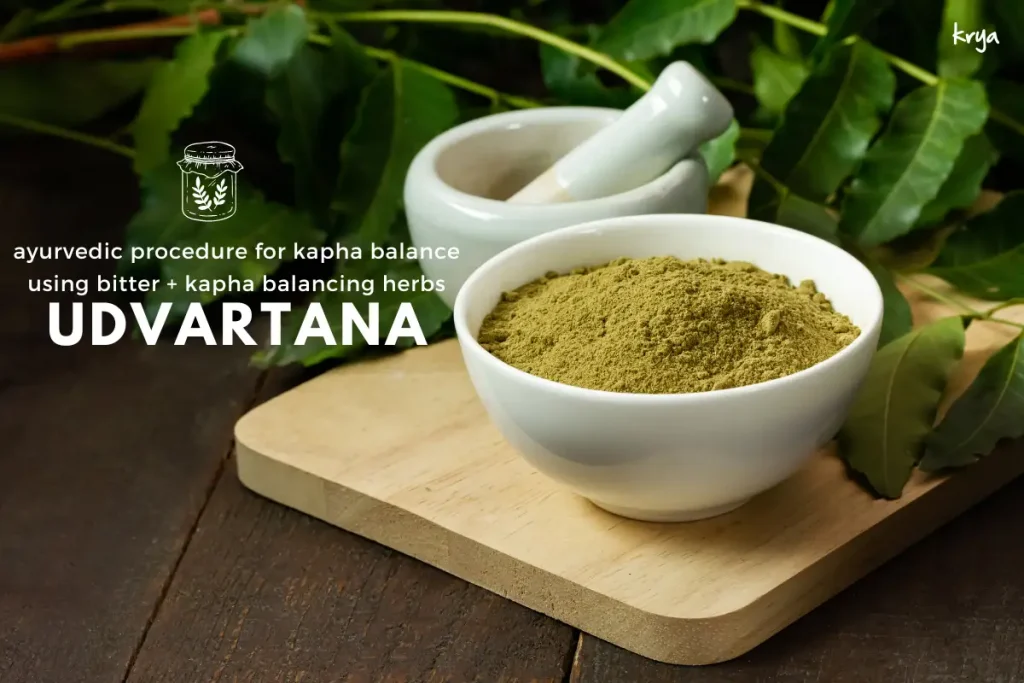
Snana choornam is a generic phrase used in Ayurvedic textbooks to describe a bathing powder made with Ayurvedic herbs. The texts give us many formulae, underlying principles and the correct process to select herbs, lentils and grains and process Ayurvedic bathing powders.
The term ubtan is used colloquially in many languages in India to refer to an Ayurvedic Snana choornam. In places like Maharashtra, ubtan is referred to as “Utane”. In states like Tamilnadu, ubtan is referred to as “Kuliyal podi” or bathing powder.
Therefore, the general meaning behind ubtan is an Ayurvedic bathing powder or Snana choornam made from a combination of lentils, grains, clays and Ayurvedic powders. As this is a generic term, there is no ONE single formula or remedy across Ayurveda. Instead we are given guidelines and information on how we can formulate different Ubtans for different prakritis and different needs.
What are the ingredients used in an ayurvedic ubtan recipe ?
Every Ubtan, as we’ve mentioned previously, does not follow a standardized formula. There are many posts on the internet which specify that an ubtan MUST contain besan (gram flour), turmeric, rose water, milk etc.
We will cover liquids in the next part of this post.
However, there is no stringent rule specified in Ayurveda that an ubtan or Snana choornam must contain one ingredient or the other.
Certain ingredients may not suit different kinds of skin or may not be suitable in certain seasons. For example, gram flour / besan very strongly removes oil, as does rice flour. Both may not be suitable in seasons like Hemanta ritu or Shishira ritu (Ayurvedic winter).
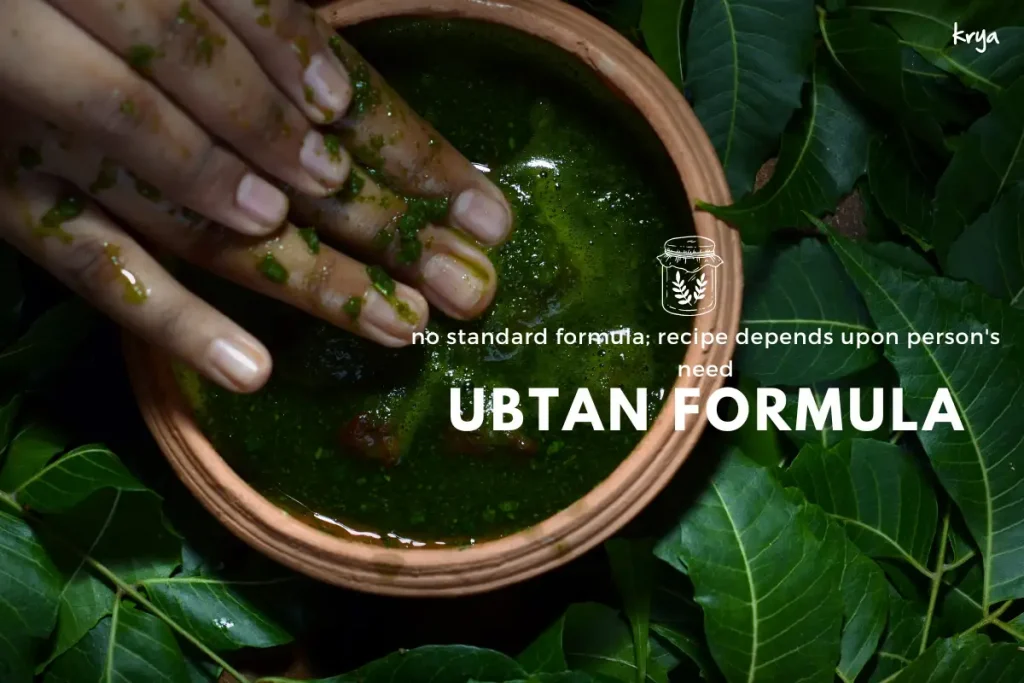
For extremely sensitive Pitta prakriti skin, a large amount of turmeric used in the product can heat the skin and cause minor inflammation.
Therefore, an ubtan formulation must be created to suit a particular prakriti or skin condition. A generic ubtan will only work for a small proportion of the population.
This is again to reiterate: while an ubtan sounds simple and generic, Ayurvedic skin care is complex and sophisticated. So creating an ubtan formulation must take the holistic principles of Ayurveda into mind and create specific products that can solve specific skin issues.
How should I mix my ayurvedic ubtan? Should Milk be used in the ubtan paste?
Liquid ingredients that are added to mix an ubtan or Ayurvedic choornam are technically called Anulepana in Ayurveda. Anulepa is any material, usually liquid that is added to a Snana choornam (bathing powder) or Lepa (mask) in order to add specific properties to the liquid.
Depending upon our need we can add Anulepana to moisturize or nourish skin, to have an astringent or toning effect, to shrink and bind skin to clear out immunities or even to perform more complex roles.
So if we are interested in buying or making a good ubtan, we must make a difference between the ubtan formula itself and the Anulepana.
If we have access to a good company’s Ayurvedic ubtan, we do not need to add heavy Anulepana like milk, rose water etc. such anulepanas are usually added to homemade ubtans. This is because at home ubtans use very simple and easy to use and process ingredients.
Whereas an Ayurvedic company can use a wider range of ingredients including difficult to process barks, roots etc. Therefore, such formulations can simply be mixed using Water as an Anulepana.
An ubtan is intended for Snana after Abhyanga & not on dry un-oiled skin
Here’s the ONE thing most people don’t know about using an Ubtan. An Ubtan is designed to be a post Abhyanga Snana product. This means you should ideally be using it on well-oiled skin and NOT on dry skin.
If you go through the review section of most commercial ubtans, you will see people comment that they don’t use the product regularly as it leaves their skin dry, or it does not suit the skin in winter.
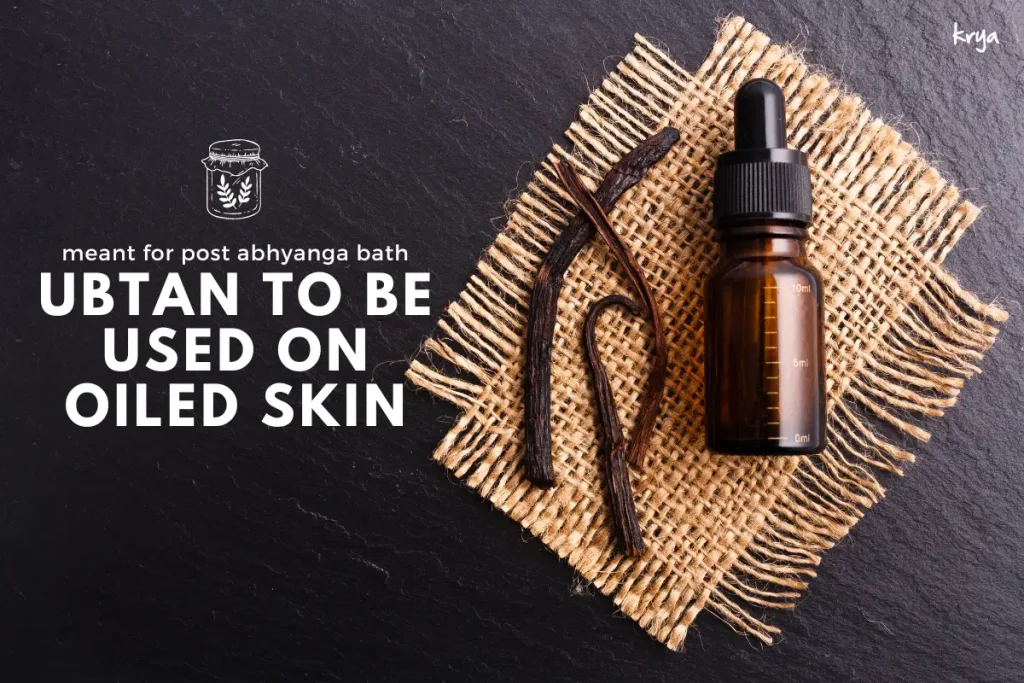
This is because apart from those with naturally oily skin or in warm humid climates or seasons like summer, an ubtan cannot be used as is on dry skin. This is why there is such a large emphasis on adding moisturizing anulepanas like milk to it. If your skin is unoiled, an ubtan may be too drying for skin. Read more about the benefits of Abhyanga here & ancient Indian oil bath here. Please also explore our Classic Abhyanga oil for Pitta balance here and our Intense Abhyanga oil for Vata balance here.
What are the benefits of ubtan according to Ayurveda?
To answer the question ” what is ubtan” simply, an Ubtan is a Snana choornam (bathing powder) in Ayurveda, which is used on well-oiled skin. In order to balance Kapha on the skin and cleanse skin well, we use a mixture of oil removing, astringent and Kapha balancing herbs in the Ubtan.
The benefits a well-crafted Ubtan can therefore have are:
· Well cleansed skin
· Excess oil is removed
· Cleansing is done without disturbing the complex microbiome colony on skin
· The skin is not stripped dry of oils, provided it is well oiled and the ubtan itself has been well formulated
Is it safe to use ubtan on the face or as a face pack ?
Facial skin is usually much thinner and more sensitive compared to body skin. Facial skin has a rich number of nerve endings and micro blood vessels – the density of these nerve and blood vessels is very high in the facial region.
This makes facial skin very sensitive to cleansing or any substance we apply on the skin.
Facial skin is also much more thinner compared to body skin. Because it is usually well exposed to heat, wind and light, the skin layers are much thinner with lesser collagen levels in this area.
Facial skin today is also much more sensitized due to the use of makeup, synthetic cleansers and higher pollution levels. It easily clogs and develops minor inflammations.
This means we have to be extremely careful when choosing products for facial skin. An oil which is used for our body cannot be applied on facial skin as it may be too thick and heavy for facial skin a clog it or cause breakouts. If we do not oil facial skin well, we should not use an ubtan as it could be too drying. Using an ubtan directly on unoiled facial skin can strip it much more quickly of natural oils compared to body skin.
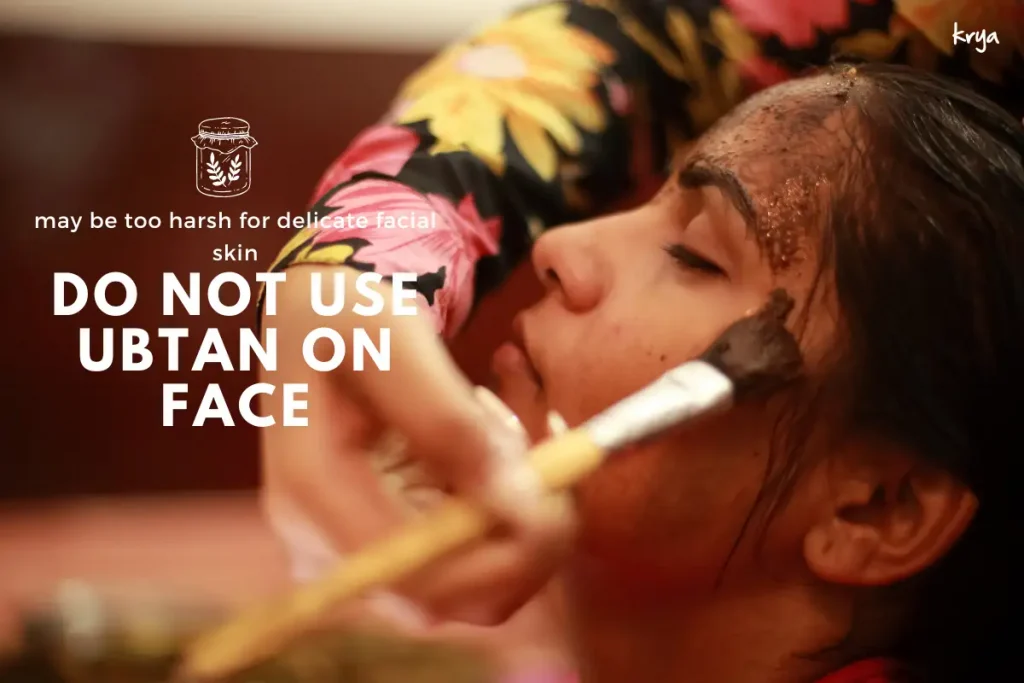
Ubtans also may be too drying and astringent for facial skin which needs a slightly different formulation.
Plus in body care, we also look at other issues like body odour, sweat, etc. Facial skin has different concerns. People expect facial skin to be well balanced, have better clarity and glow. Therefore a standardized ubtan formulation is unsuitable for facial skin. You should definitely not use an ubtan for your face. Instead, you should use a product that has been specially formulated for facial skin keeping its sensitivity delicacy and special concerns in mind. Here’s a detailed article on how to use a face wash powder to delicately cleanse facial skin.
A face mask / lepa is an excellent skin treatment. However here, the product is usually mixed with a special anulepana and then left for 20-45 minutes on skin to deep cleanse skin, clear srotas and balance the doshas on the skin. When done with the right products this can have a positive impact on skin clarity and appearance. However, again, ubtan may not be a suitable product for a face lepa. Read more on this detailed post on how to use face masks correctly for better skin.
Can ubtan remove body hair?
Excess hair is something many Indian women are concerned about. Our rich kapha filled diets, sedentary lives high consumption of artificial hormone-laced dairy, or excessive amounts of soy, may be leading to a slight imbalance in hormonal levels . This results in conditions like PCOD, and excessive facial hair and body hair.
The use of rooksha (dry), and astringent herbs daily in the Snana does help the thin down body and facial hair. If the underlying condition is an imbalance, the hair may be thicker and spiky – this needs to be tackled internally through a good diet, a suitable exercise program and ayurvedic medicines.
However, the use of Snana choornams with rooksha and astringent herbs, especially if used regularly will help thin down and weaken body and facial hair. However, if there is an underlying condition that has not been addressed, there will continue to be new growth of hair which you have to then work on with your Ubtan.
Please note that Ubtan or snana choornam or even Ayurvedic face wash powder cannot have a depilatory effect. For true depilation, we have to use highly alkaline herbs like Ksharas . Such herbs can be very irritating to skin.
Herbs like Turmeric, and Kasturi Turmeric, are not depilatory in their action. So they do not remove body hair like waxing shaving or threading does. When used regularly, they simply thin down hair and weaken it.
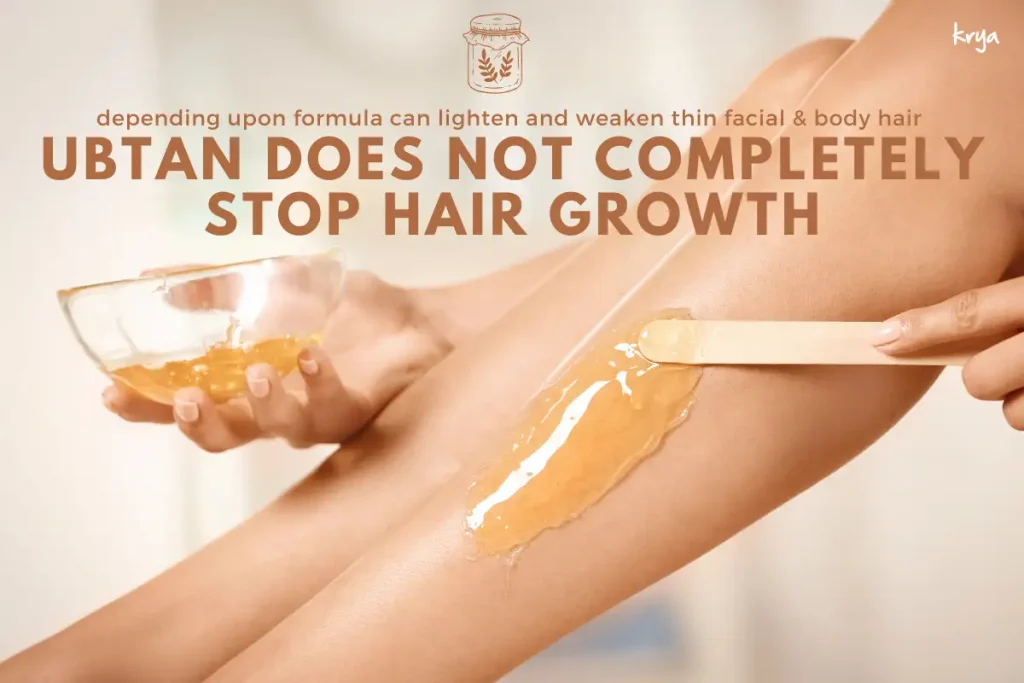
Today there are many products advertised as a natural depilatory, sometimes even claiming an ayurvedic status. If you read the ingredient list very carefully you will find chemical depilatories used like salts of thioglycolic acid, etc. Any product that works instantly will usually use a chemical ingredient. Such products are not safe or good for skin.
If you have excessive facial or body hair, please start by investigating the cause. If there is an internal issue , please address this first by consulting a Vaidya. Usually when the underlying cause has been treated the problem of excessive body hair will also reduce.
As a supplement, you can try a well-formulated Ayurvedic ubtan in addition for body hair. Use it regularly to see a good effect. In Krya, you can also try our Mangalya Lepa which is formulated with 6 different kinds of turmeric – the combination is made along with nourishing herbs like Yashtimadhu and Amla. You can add this into your ubtan along with some milk to prevent any over drying or sensitization of skin.
What to apply after ubtan?
As ubtan is to be used on well oiled skin, there is no need to apply an additional moisturizer or any such product after using an ubtan.
In fact, Ayurveda does not suggest using an extensive amount of product on skin after bath as it could interfere with the basic functioning of skin. The skin contains minute tubular structures called Srotas which end in pores on the surface of the skin. These Srotas help in the thermoregulatory exchange that skin does and help transport sweat, oils, triglycerides to the surface and help maintain the body at the right temperature, and also help feed the natural microbiome colony, regulate oil production on skin, etc.
Applying a thick / greasy layer of external products after cleansing can slow down and interfere with the skin’s normal work. Therefore you may avoid post bath application of moisturisation of products, provided you have used the ubtan in the correct way.
What is the difference between the way Ubtans and Soaps clean skin?
Ubtans and natural snana choornams clean intelligently compared to synthetic soaps. They conserve skin microbiome and only remove excess oils and dirt from skin. Read more about the intelligent cleansing action of ayurvedic snana choornams here.
Does ubtan lighten skin?
Skin colour is determined genetically and is determined by many factors according to Ayurveda like time of conception, parents’ prakriti, diet followed by mother, mental gunas of parents at time of conception. Therefore no product can fundamentally alter the inborn colour of skin (even though a leading search term that gets people to our site is the quest for glowing skin).
That said, skin clarity and texture are often affected by factors like excessive sun exposure, poor diet, poor circulation, etc. These factors temporarily dull and affect the clarity and glow of skin. Such factors can definitely be worked on.
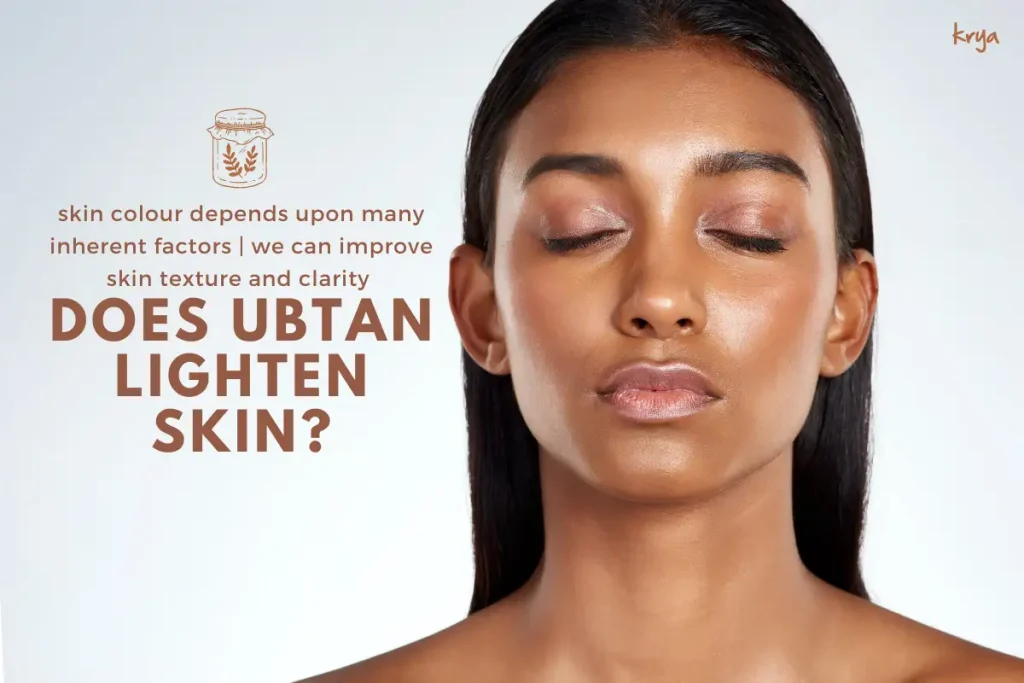
As an ubtan is formulated with astringent, skin healing herbs, here are some of its benefits for the skin :
1. Improve microcirculation in the skin
2. Cleanse skin gently (and depending upon the formulation)
2a. Mildly exfoliates skin, removes dead skin, without stripping it of natural oils (this is true of skin is pre-oiled or other nourishing substances like milk are added to the ubtan as an anulepana medium)
3. Balance the local doshas in skin improving skin clarity, appearance, and texture
4. Heal and treat minor skin inflammations and local issues
5. Improve skin health over time – so the fresh skin cells have good clarity, glow and softness
When choosing an ubtan, it is important to understand your skin type and concerns and pick the right product for your skin.
If you have concerns about this, please contact our customer service associates.
Is ubtan helpful for oily skin?
Oily skin indicates a specific imbalance in skin according to Ayurveda. Pitta imbalance causes excessive oiliness and skin sensitivity leading to acne and breakouts. Using a one-off product cannot help balance oily skin correctly. Read this detailed article on an ayurvedic skin care routine for oily skin.
Does ubtan remove facial hair?
We have answered this question previously.
Can ubtan masks be used daily?
If you are pre-oiling skin everyday or doing an abhyanga every day with a good Ayurvedic oil, an ubtan can be used every day. However, as explained previously, an Ubtan should not be used on facial skin as it may e too drying and astringent for facial skin.
If it is not possible to pre-oil your skin every day, an Ubtan is NOT advisable for daily use. Instead, you can use a milder Snana choornam which has been expressly formulated for unoiled skin.
At Krya we have developed a range of Snana choornams which are meant for daily use on unoiled skin. We call the products Ayurvedic bodywashes. We have formulated them for different skin types and concerns. Please explore these products here.
What is the difference between an Ubtan and Krya’s Bodywash powders?
An Utan is formulated to be used on well oiled skin. Therefore it contains herbs which are rooksha and astringent which help remove excess oil properly.
As Krya’s bodywash powders are formulated for use on non oiled skin, we use a combination of herbs which have madhura rasa and are unctuous and nourishing along with herbs that have a cleansing effect. We also carefully follow seasonal guideines when we formulate our bodywash powders and use herbs that are compaile with the weather in each season. We follow seasonal guidelines for ubtans as well, but we need to be more careful in our body wash powders as we are working with un-oiled skin which is more delicate.
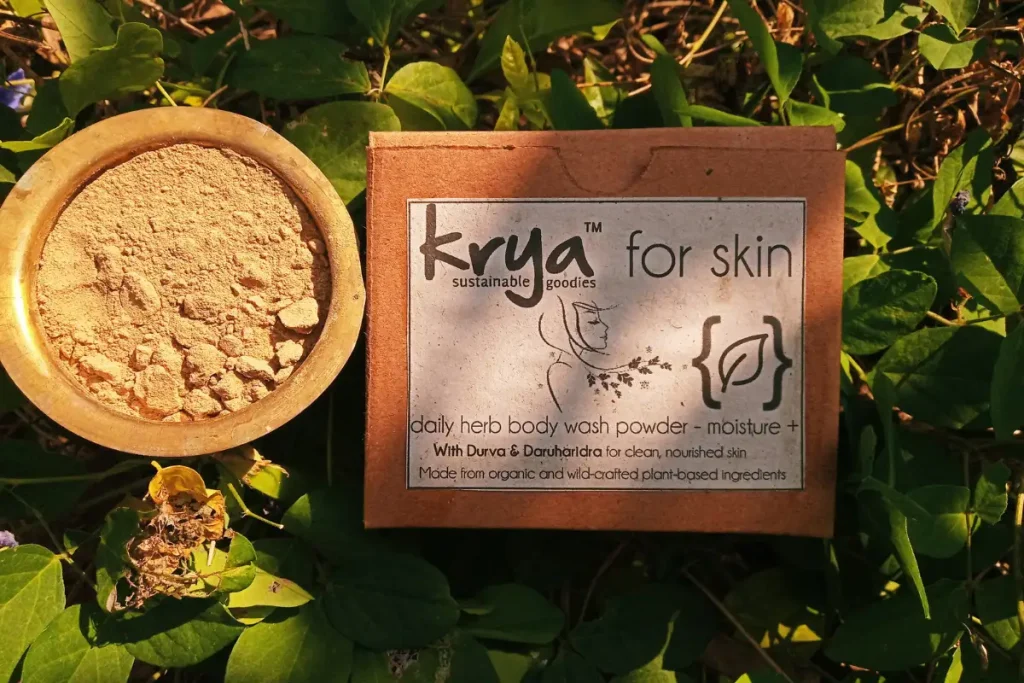
Therefore Krya’s body wash powders can be used daily for a bath , on unoiled skin. However they are NOT suitable for facial skin and not suitable for post Abhyanga bath.
As we have already explained, facial skin needs a different approach because of the sensitivity and delicacy of the skin. For facial cleansing we have a specially formulated range of face wash powders.
Oiled skin needs a product with higher astringency and herbs which are more drying in nature. For this you can use an ubtan or even use one of our ubtans – The Krya body wash powders cannot cleanse high level of oil very thoroughly and may leave te skin feeling oily even after a bath. For this kind of stronger cleansing please try one of our ubtans instead.
Does ubtan remove acne scars?
Acne is a problem of 2 doshas going out of balance. We have explained in detail the etiology of acne in this earlier article.
Acne scars and pits form as a result of long term cystic acne. Picking, manipulating and using harsh products which superficially dry out the acne without tacking the root cause can all lead to the spread of acne and result in scarring and pits.
To treat acne prone skin, we need to do 3 things:
· Unclog and deep cleanse the skin, especially the Srotas
· Work with the skin and assist the regenerative process
· Discourage the growth and spread of microbes that can infect the Srotas and increase the chance of comedones and cystic acne
Apart from these 3 things, the acne sufferer needs to look at their diet and regimen and work on improving pitta and kapha balance.
An ubtan is first off too strong for facial skin, which is extremely delicate. Secondly, the purpose of ubtan is to simply cleanse and remove excess oil. It is not hyepr focused on healing skin and discouraging active microbial growth. Plus it is not formulated to support skin in its healthy regeneration. Additionally a choornam or a Lepa formulated for Acne will focus on declogging the Srotas actively, not just surface-level oil removal or basic cleansing.
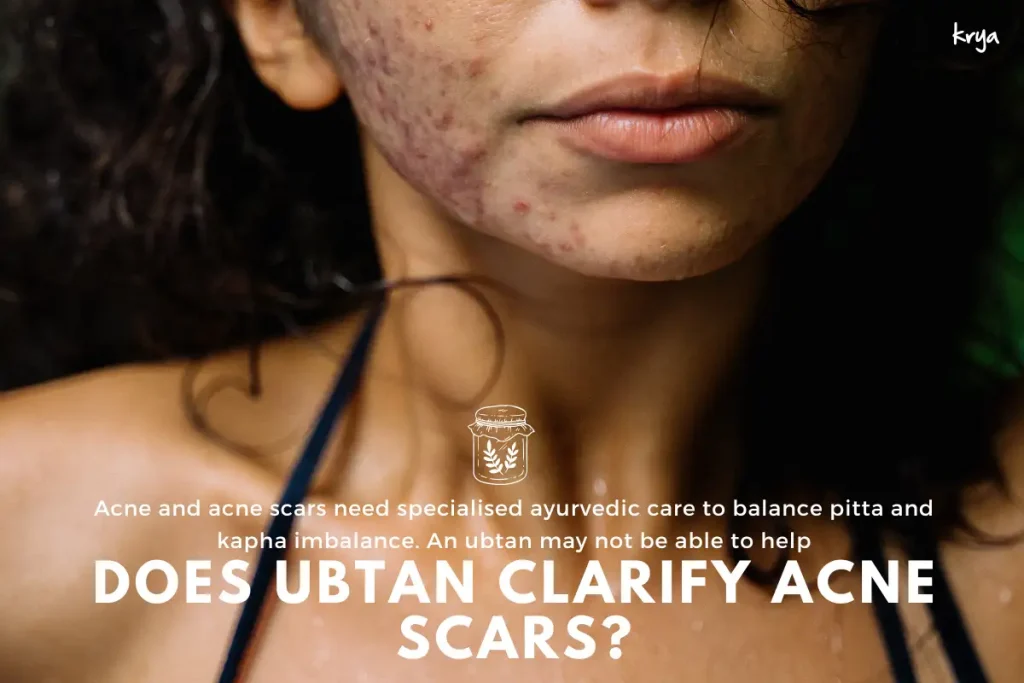
For all these reasons, an ubtan is not the ideal product to work on acne scars. Acne needs a gentle daily face wash that deep cleanses skin and balances Pitta and Kapha. It needs a twice a week face Lepa or mask which strongly works on healing skin, flushing out microbes and bringing down the pitta kapha imbalance.
It also needs a well-formulated Ayurvedic oil / serum that assists skin in healthy regeneration, while respecting its inherent nature and not over nourishing skin or giving the microbes excessive food to proliferate.
Instead of an ubtan, for acne prone skin choose a well formulated set of anti acne products. Explore ours here.
Can we use soap after ubtan?
We have heard this doubt from many Krya customers. To those who are not used to Ayurvedic Snana, a bath with a soap feels more complete. Many people mistakenly believe that a bath with a soap removes excess oil better and cleans skin more thoroughly.
The greatest defense we can have is the natural microbiome barrier present in skin. Unfortunately, the harsh cleansing and alkaline nature of soaps destroys this immune layer leaving us weaker and more susceptive to infections.
Soaps are also extremely harsh and drying on skin. So any good done by the ubtan is effectively rinsed away by the soap.
We have analyzed some of the properties of and issues with a baby soap in this article. You can see from our analysis how chemical laden and potentially worrisome even a so-called gentle baby soap is. The same argument can be extended to adult soaps. By their very nature they are alkaline. Therefore they are harsh on skin where the natural pH is mildly acidic. In this mildly natural pH, our microbiome thrives. Whenever we apply an alkaline product on it, it weakens our friendly colony of microorganisms.
Besides this, the nature of soap cleansing is itself different from grain and ubtan cleansing. The cleansing is much more harsher and is not tailored for skin. For these reasons, we do not recommend the use of soap. It is certainly not advisable to use soap after cleansing skin with ubtan.
Are there any side effects of ubtan or in any of the natural ingredients used in it?
In this article, we have explained what an ubtan is and how it has been formulated in Ayurveda to use after a good abhyanga where skin is well oiled. When used correctly , an ubtan has no side effects and is good for the skin.
However, when the formulation is too high on herbs which have rooksha guna (drying nature) or ushna guna (hot nature) like turmeric, and when the product is used on unoiled skin, the skin could start feeling dry after ubtan use.
So if you are experiencing side effects after ubtan, it is possible you are not using the product correctly or that the formulation is not suiting you.
How to make ubtan at home in a custom recipe?
Can you customise your ubtan? Yes you most certainly can. But should you be customizing your ubtan? That’s the question we will be answering here.
If you want to create a custom ubtan, the underlying assumption is that you know your prakriti well, understand your skin needs and also understand how your skin is changing with relation to the current climate. It also assumes you have full access to a wide range of herbs that you can process correctly in order to add to your custom ubtan formulation.
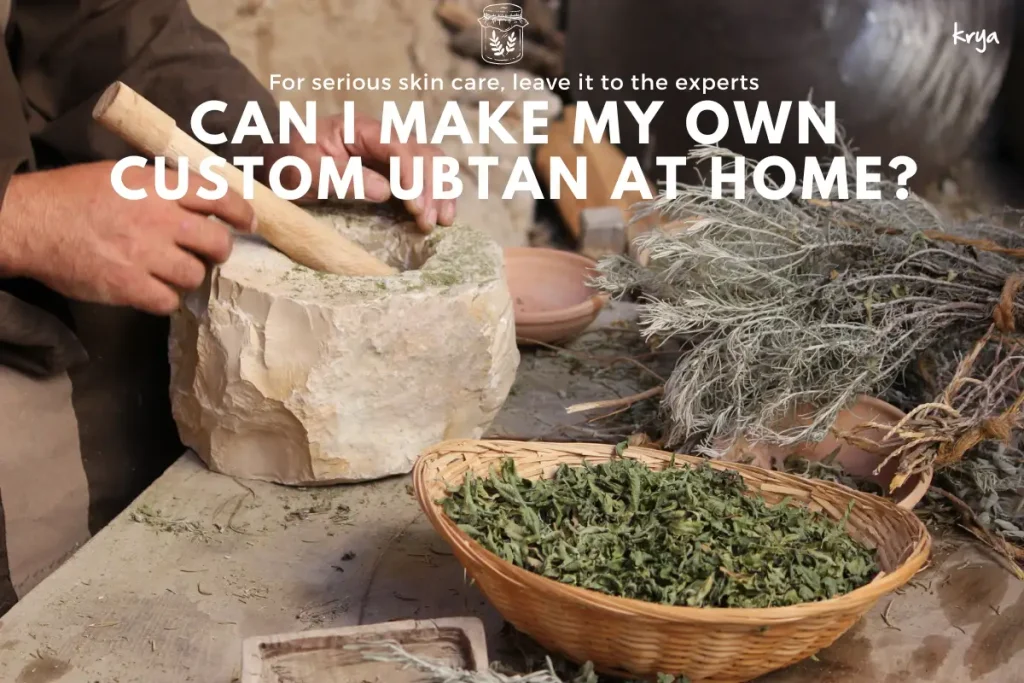
Many home made ubtan recipes use easy-to-access herbs flowers and grains. Herbs like Turmeric, Rose, Green gram are often used. It is even possible to find a few powdered herbs like Vetiver, Yashtimadhu, etc in a local Ayurvedic herb shop. But beyond these common herbs, we have literally thousands of Ayurvedic herbs available in India to treat different skin and hair concerns.
At Krya alone, we use over 200 ayurvedic herbs in our formulations. Many of these are hard to buy or process for at home recipes. However, they are extremely good for skin / hair and help with specific conditions like pitta imbalance vata imbalance, etc.
So if you don’t want a formulaic ubtan and want to work on your specific skin concerns, make sure you find a good Ayurvedic company who can help understand your needs.
Choosing from a wide range of Ayurvedic Snana choornams and finding a product that helps address your skin concern is better than attempting to customize your ubtan.
Can I use gram flour or Multani Mitti in my ayurvedic ubtan face recipe?
There are many recipes online that suggest using ingredients like turmeric , Gram flour (chickpea flour) , almond powder, , Multani Mitti, or even specific herbs like sandalwood powder, neem powder in your ubtan recipe. Should everyone use these ingredients? The answer is, of course, not really. Because every herb in Ayurveda comes with its own pros and cons , so not every herb may suit everyone.
Gram flour or Besan can often trigger Pitta-based skin sensitivities in people who are prone to these imbalances. Skin may break out into hives or feel warm and itchy. Multani Mitti or Fullers earth may be too drying for those with already dry skin. So again there is no set list of ingredients or rules when it comes to an ayurvedic ubtan. You must understand your skin and then decide what can help your skin.
Does Men’s skin need a special ubtan?
Men’s skin is structurally different from Women’s skin. Therefore it needs special products that can through cleanse skin, address the existing elevated Pitta and then work on other concerns like vata balance, pitta balance, etc. Please explore our Men’s Classic ubtan for Pitta balance and Men’s Intense Ubtan for Vata balance.
What is the correct ayurvedic ubtan recipe for my baby?
Baby’s skin has completely different needs from adults skin. It is thinner, not fully formed and therefore extremely delicate. So an adult ubtan cannot and should not be used on a baby’s skin. An ubtan for a baby must be formulated very carefully and specifically.
Do explore Krya’s ubtans for babies here.
To sum up: What is ubtan
There is a lot of noise on many ayurvedic hair and skin products of late. The ubtan has been gaining a lot of traction in the past few years with many new D2C companies labelling their products after an ubtan even though the actual products have nothing to do with an ayurvedic ubtan.
We hope this detailed post answered many basic questions about ubtan and clarified how you should choose an ubtan, what skin conditions it helps with and also how to use it correctly.
Do let us know if you found this post helpful and useful by responding below in the comment section. Thank you.

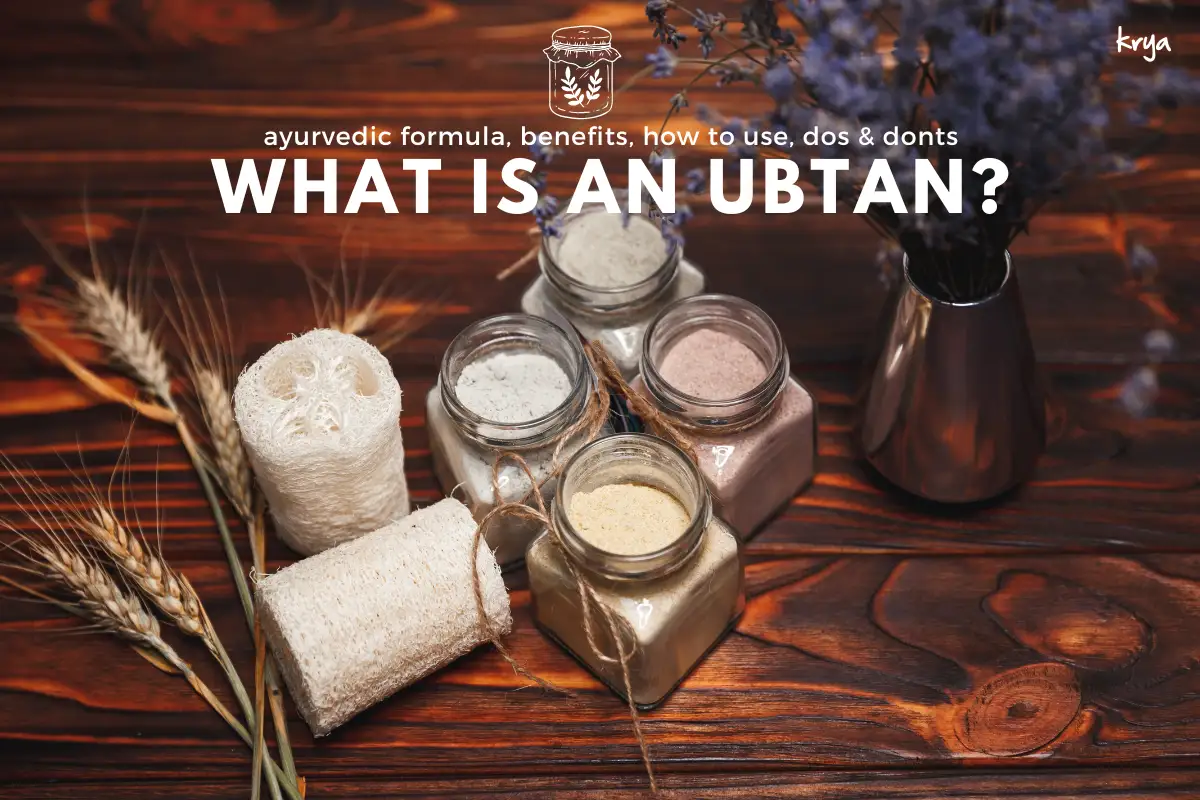

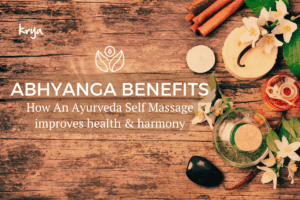


The informatiin provided was very helpfull to me. Thankyou
I have never reply to any websites befor like this krya is the first one
Still confused about one thing. Should oil be washed off from skin after abhyanga and before applying ubtan? How will the ubtan penetrate the oil and influence the skin otherwise?
Hi there,
A part of the ubtan’s job is to cleanse skin of excess oil. Which it will do if you use it to bathe after an abhyanga. The rest of what it does occurs along with the cleansing. The cleansing is an integral part of the job – so you should not use any other cleanser and than an ubtan as it cold then dry out your skin. Hope this clarifies?